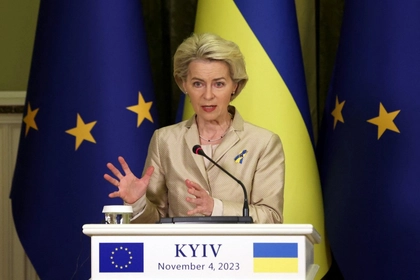Ukrainian commandoes blew up three helicopter gunships at a Russian military airfield close to the Latvian border, in one of the most spectacular behind-the-lines raids launched by either side since the beginning of the Russia-Ukraine war, multiple sources confirmed on Tuesday, Nov. 1.
The Main Intelligence Directorate (GUR) of the Ministry of Defense of Ukraine said in a Monday, Oct. 31 statement that the Oct. 30 attack took place at the Russian army’s Veretye air base in north-western Pskov Region. The facility is more than 500 km., as the missile flies, from Ukraine to the south, and some 110 km from NATO member Latvia to the east.
Two Ka-52 attack helicopters were destroyed completely and a third was badly damaged by det charges placed by Ukrainian operatives infiltrating in and out of the site without being detected, the GUR statement added. Russian security teams subsequently found a fourth helicopter rigged with explosives that had not gone off, some news reports said.
The Ka-52 “Alligator” helicopter is one of the Kremlin’s latest combat aircraft and has been widely profiled on state-controlled media as an example of growing Russian military might. In serial production since 2007, the $16 million aircraft is equipped with a multi-level digital computer-based system, a helmet-mounted sight display, advanced navigation, and hard points for anti-tank missiles, ground attack rockets, and aerial bombs.
Multiple Russian Telegram channels have confirmed that the attack took place. Some initially challenged Kyiv’s capability to pull off such an attack, but even pro-Kremlin information platforms conceded the Ukrainian success following the Oct. 31 appearance of video of the actual sabotage operation in progress.

EU Transfers €1.5 Bln Raised From Russian Assets for Ukraine
Originally published on the Telegram channel Orestokratiya, an information platform run by the management of Ukraine’s Obozrevatel magazine, the video shows an unarmed man in military attire preparing and planting explosives in the fuselage of a Ka-52 helicopter parked on the concrete tarmac of what appears to be a Russian army airfield. Russian soldiers are nowhere to be seen.
The Starshie Eddy Telegram channel, a pro-Kremlin information platform focusing on military developments, wrote: “Let’s be frank, this is a gross failure on our side. Yes, we need, immediately, much more severe punishment for those who are tracking (derogative swear word for Ukrainians) inside Russia. If it’s possibly to calmly blow up a helicopter on the grounds of military unit, what can we say about our less protected sites?”
Yuriy Butusov, a leading Ukrainian military journalist, said in a Facebook comment that the strike was “One of the best sabotage operations of the GUR…the saboteurs entered the territory of a particularly important military base, went unnoticed to the helicopter parking lot, installed four explosive devices, that is, wasted some time, set a timer and also left the territory of the air base unnoticed.”
Russian independent journalists penetrated Veretye base in December 2019, exposing poor security at the airfield at the time with a video of them entering and leaving the airfield without interference, or even spotting a guard, the Ukrainian UNIAN news agency reported on Tuesday, Nov. 1.
News of the Veretye strike became public two days after a dramatic Armed Forces of Ukraine attack on Russian Black Sea Fleet (BSF) warships off shore from their base in Sevastopol, in the Russian Federation (RF)-occupied Crimea peninsula. RF military spokesmen said Ukrainian special forces used remoted-controlled motor boats loaded with explosives to attack three BSF warships, slightly damaging one.
Independent Ukrainian news platforms said the Oct. 29 naval raid damaged at least two Russian vessels, one a frigate armed with long-range cruise missiles used to hit Ukrainian civilian targets. Kyiv military spokesmen confirmed Ukrainian special forces were behind the attack.
A picked force with a listed strength of some 5,000 men and women, the Special Forces of Ukraine (SSO) began a shift to NATO-style training and tactics in 2014, following the Kremlin’s forced annexation of Crimea and invasion of Ukraine’s Luhansk and Donetsk Regions. SSO leadership and even rank-and-file have since then trained frequently with NATO counterpart units, particularly from the U.S., Great Britain, Poland and the Baltic States
You can also highlight the text and press Ctrl + Enter






